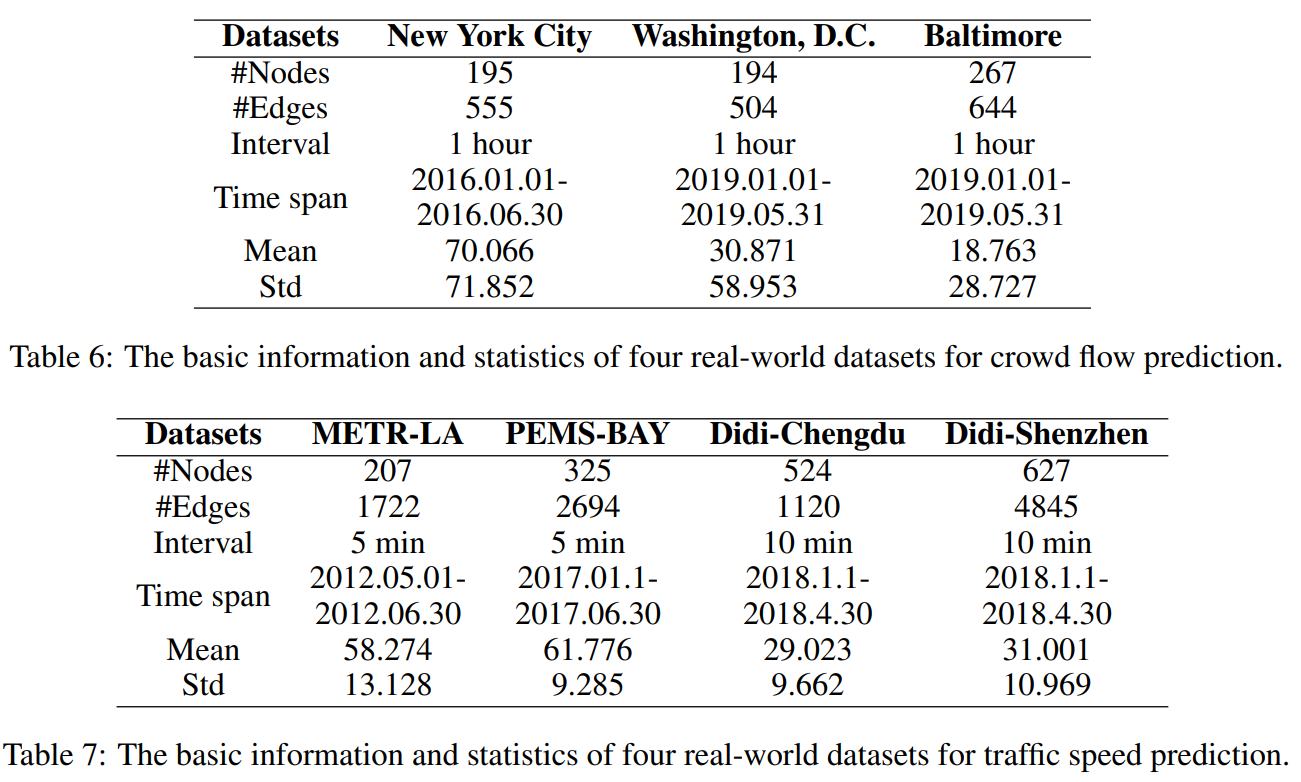The official implementation of the ICLR 2024 paper entitled "Spatio-Temporal Few-Shot Learning via Diffusive Neural Network Generation".
In this project, we propose a novel framework, GPD, which performs generative pre-training on a collection of model parameters optimized with data from source cities. Our proposed approach recasts spatio-temporal graph transfer learning as pre-training a generative hypernetwork, which generates tailored model parameters guided by prompts. Our framework has the potential to revolutionize smart city applications in data-scarce environments and contribute to more sustainable and efficient urban development.
- Tested OS: Linux
- Python >= 3.8
- torch == 1.12.0
- torch_geometric == 2.2.0
- Tensorboard
- Install Pytorch with the correct CUDA version.
- Use the
pip install -r requirements.txtcommand to install all of the Python modules and packages used in this project.
The data used for training and evaluation can be found in Time-Series data. After downloading the data, move them to ./Data.
For each city, we provide the following data:
Graph data: It records the adjacency matrix of the spatiotemporal graph.Time series data: It records the temporal sequential data for each node.
We provide two time-series datasets: crowd flow (including DC, BM, man) and traffic speed (including metr-la, pems-bay, shenzhen, chengdu_m).
The details of these two data sets are as follows:
To train node-level models with the traffic dataset, run:
cd Pretrain
CUDA_VISIBLE_DEVICES=0 python main.py --taskmode task4 --model v_GWN --test_data metr-la --ifnewname 1 --aftername TrafficData
After full-trained, run Pretrain\PrepareParams\model2tensor.py to extract parameters from the trained model. And put the params-dataset in ./Data.
To train diffusion model and generate the parameters of the target city:
cd GPD
CUDA_VISIBLE_DEVICES=0 python 1Dmain.py --expIndex 140 --targetDataset metr-la --modeldim 512 --epochs 80000 --diffusionstep 500 --basemodel v_GWN --denoise Trans1
expIndexassigns a special number to the experiment.targetDatasetspecifies the target dataset, which can be selected from ['DC', 'BM', 'man', 'metr-la', 'pemes-bay', 'shenzhen', 'chengdu_m'].modeldimspecifies the hidden dim of the Transformer.epochsspecifies the number of iterations.diffusionstepspecifies the total steps of the diffusion process.basemodelspecifies the spatio-temporal graph model, which can be selected from ['v_STGCN5', 'v_GWN'].denoise modelspecifies the conditioning strategies, which can be selected from ['Trans1', 'Trans2', 'Trans3', 'Trans4', 'Trans5'].- Trans1: Pre-conditioning with inductive bias.
- Trans2: Pre-conditioning.
- Trans3: Pre-adaptive conditioning.
- Trans4: Post-adaptive Conditioning.
- Trans5: Adaptive norm conditioning.
The sample result is in GPD/Output/expXX/.
To finetune the generated parameters of the target city and evaluate, run:
cd Pretrain
CUDA_VISIBLE_DEVICES=0 python main.py --taskmode task7 --model v_GWN --test_data metr-la --ifnewname 1 --aftername finetune_7days --epochs 600 --target_days 7
taskmode'task7' means finetune after diffusion sampling.modelspecifies the spatio-temporal graph model, which can be selected from ['v_STGCN5', 'v_GWN'].test_dataspecifies the dataset, which can be selected from ['DC', 'BM', 'man', 'metr-la', 'pemes-bay', 'shenzhen', 'chengdu_m'].ifnewnameassign 1 to better distinguish the results of the current experiment.afternameUse with --ifnewname 1 to give an identification name to the log file and results folder of the current experiment.epochsspecifies the number of iterations.target_daysspecifies the amount of data used in finetune stage.
Let me give an example of the overall instructions. If you want to set 'metr-la' as target city:
- In pretrain: set the
test_dataas 'PMS-Bay', 'Didi-Chengdu', and 'Didi-Shenzhen' respectively to pretrain the models of other three source cities. - In Diffusion: set the
targetDatasetas 'metr-la'. - In finetune: set the
test_datasetas 'metr-la'.
Since finetune and pretraining share the same code framework and use the same set of parameter names, this can be a little confusing and I will try to make the distinction between them in later versions of the code.
@inproceedings{
yuan2024spatiotemporal,
title={Spatio-Temporal Few-Shot Learning via Diffusive Neural Network Generation},
author={Yuan Yuan and Chenyang Shao and Jingtao Ding and Depeng Jin and Yong Li},
booktitle={The Twelfth International Conference on Learning Representations},
year={2024},
url={https://openreview.net/forum?id=QyFm3D3Tzi}
}

